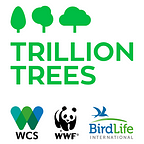Fighting for the planet — one community at a time
It was the power of the waterfall, framed by trees of the forest, that I’ll remember the most.
Earlier this month I was fortunate to visit a Trillion Trees forest restoration site in Kabale, a small village in the Msasani area of Rwunge district, up in the Southern Highlands of Tanzania. We’d hiked up to the hills to a rolling landscape that had provided water to the local villages, but that had, over the last decade slowly been converted to farming and grazing.
The gradual loss of forest and lush undergrowth meant that the volume of water collected by nature and that fed the stream was reducing each year. As a result, the community struggled to have enough to irrigate their crops.
So, in the two years before I visited, the conservation team - led by the Wildlife Conservation Society (WCS) - had been working with the farmers and village natural resource committee (VNRC) to find ways to supplement the community’s income using methods that allowed them to leave the land alone, giving it a chance to regenerate naturally. They planted a few native trees to help the process along, but overall, the main thing was to let nature have a chance to restore itself.
Before we left Mbeya, the regional capital, I’d been shown a picture of the waterfall before the agreement was put in place. It was a small, glittering source of natural water, surrounded by vegetation but also by flat agricultural land, full of crops.
What I saw when we arrived, however, felt as if we’d been transported to another planet. One that was covered in greenery, one where newly planted native trees already reached nearly 60cm tall, and one in which the waterfall had DOUBLED in size, sending a spray of mist across the small valley we stood in.
The local VNRC was delighted because the increase in water meant they could actually grow more crops in the land they were still using. The surrounding villages had heard about the positive results and were interested in how they could participate. This was, in every sense, true community mobilization: powered to improve both the natural world AND economic outcomes for local people.
How had this happened? What can we learn and adapt from this success, as the urgency of the climate and biodiversity crises increases?
First, it confirms yet again that climate action requires not just community involvement, but community partnership. If there hadn’t been trust between our team and the people who call this area home, this first conversation about changing land use wouldn’t have gone anywhere.
Second, this success was achieved because economic imperatives were put front and centre of the work. In finding ways to compensate for the immediate loss of crops revenue and in delivering on the promise of long-term economic benefits of restoring the ecosystem (more water for all), this piece of conservation recognized that the drivers of deforestation are often very simple: communities need resources to thrive.
And probably the biggest take away for me? In terms of the global forest restoration agenda, this crystalized for me yet again that restoration is as much a part of preserving our forests as it is about creating protected areas. You can plant as many trees as you like, you can call millions of them together a forest if you like, but in reality, if we want to address the triple challenge of climate change, crashing loss of wild- and plantlife, and the increasing inequality of economic opportunity for communities, we MUST try to restore nature as part of the human and economic landscape. Otherwise we’re in danger of valuing nature only as a soulless calculation of carbon storage capacity, and ignoring what’s happening around these ‘carbon banks’.
This would be a mistake — because the village elders I met couldn’t care less about how much carbon their forest (the one they have jurisdiction over) can store. They are looking to the future, their own and their children’s. The trees are a means to an end, but a different one from the carbon conversations most of us are having.
Food for thought, for all of us.
